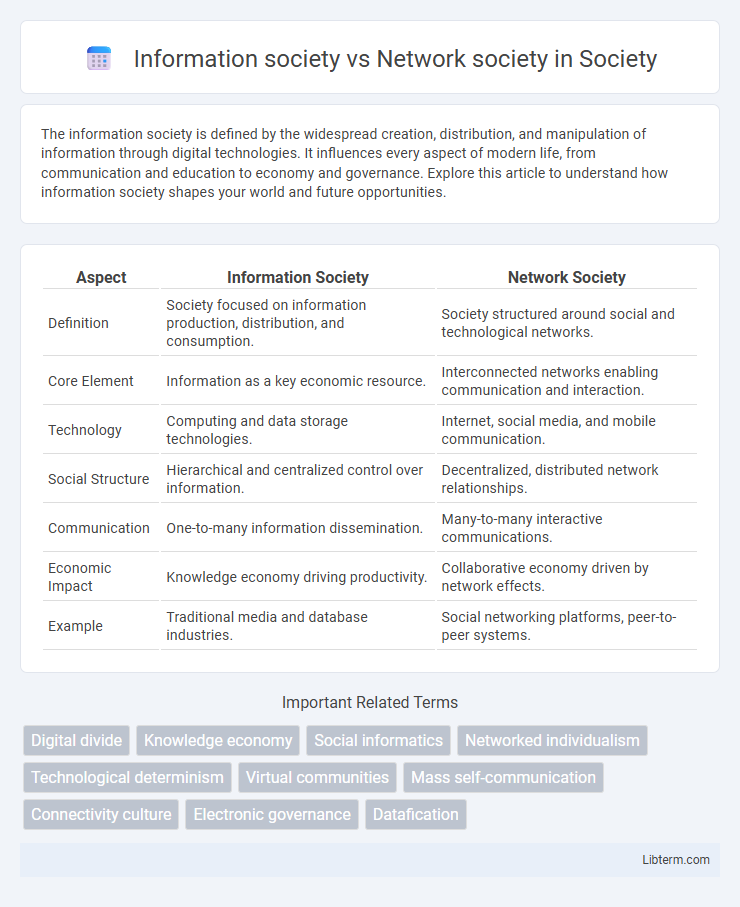The information society is defined by the widespread creation, distribution, and manipulation of information through digital technologies. It influences every aspect of modern life, from communication and education to economy and governance. Explore this article to understand how information society shapes your world and future opportunities.
Table of Comparison
| Aspect | Information Society | Network Society |
|---|---|---|
| Definition | Society focused on information production, distribution, and consumption. | Society structured around social and technological networks. |
| Core Element | Information as a key economic resource. | Interconnected networks enabling communication and interaction. |
| Technology | Computing and data storage technologies. | Internet, social media, and mobile communication. |
| Social Structure | Hierarchical and centralized control over information. | Decentralized, distributed network relationships. |
| Communication | One-to-many information dissemination. | Many-to-many interactive communications. |
| Economic Impact | Knowledge economy driving productivity. | Collaborative economy driven by network effects. |
| Example | Traditional media and database industries. | Social networking platforms, peer-to-peer systems. |
Defining Information Society
The information society is characterized by the central role of information production, processing, and distribution in economic and social activities, driven by advancements in information and communication technologies (ICT). It emphasizes the transformation of traditional industries through digital data management and knowledge-based services, shaping new social structures and cultural practices. Key indicators include widespread internet access, digital literacy, and the expansion of the knowledge economy as foundational to economic growth and societal development.
Understanding Network Society
Network society refers to a social structure where information and communication technologies (ICTs) enable real-time connectivity and interaction across global networks, reshaping economic, cultural, and political dynamics. Unlike the information society, which centers primarily on the production and dissemination of information, the network society emphasizes the relational and decentralized nature of these digital networks. Understanding network society involves analyzing the impact of digital platforms, social media, and cyber-infrastructure on social organization, power distribution, and knowledge flows.
Historical Context and Evolution
Information society emerged during the late 20th century with the rise of mass computing and digital data storage, emphasizing information production as a key economic driver. Network society evolved from the 1990s onward, driven by the proliferation of the internet and digital communication technologies that transformed social structures through interconnected platforms. Historical shifts in media, telecommunications, and global connectivity underpin the transition from isolated information silos to integrated networked systems shaping modern social dynamics.
Core Characteristics of Information Society
The Information Society is defined by its reliance on the generation, processing, and distribution of information as a central economic, social, and cultural activity. Core characteristics include widespread access to digital technologies, a high degree of information flow, and the dominance of knowledge-intensive industries. Unlike the Network Society, which emphasizes the interconnected structure of social networks and digital communication, the Information Society focuses on the production and use of information as a primary resource.
Key Features of Network Society
Network society centers on the dominance of digital communication networks that structure social, economic, and political interactions globally, highlighting the primacy of real-time information flows and connectivity. Key features include decentralized information technologies, the enabling of virtual communities, and the reconfiguration of power dynamics through networked communication platforms. This framework contrasts with information society's broader focus on knowledge production and dissemination, emphasizing instead the interdependent, algorithm-driven, and data-intensive nature of social organization.
Technological Foundations: Differences and Similarities
The Information Society is grounded in the widespread use of information and communication technologies (ICT) such as computers, databases, and telecommunications to store, process, and distribute data, emphasizing information as a key economic and social resource. In contrast, the Network Society is built on advanced digital networks, particularly the internet and mobile technologies, that enable real-time, decentralized communication and social interaction across global nodes. Both societies rely on ICT infrastructures but differ in their technological focus: Information Society centers on information processing and management, while Network Society prioritizes connectivity and interactive social networks.
Social Impacts: Communication and Community
Information society emphasizes the widespread access and use of information technologies, transforming communication by enabling mass dissemination of data and fostering global awareness. Network society focuses on the interconnectedness of individuals and organizations through digital networks, reshaping social relationships by facilitating real-time interaction and collaborative communities. These shifts enhance social inclusion and community building but also challenge traditional social structures and privacy norms.
Economic Transformations in Both Societies
Information society emphasizes the widespread creation, distribution, and use of information as a key economic resource, driving shifts toward knowledge-based industries and enhancing productivity through digital technologies. Network society, by contrast, centers on the pervasive connectivity enabled by digital networks, facilitating decentralized economic activities, real-time communication, and global collaboration that reshape traditional market structures. Both societies experience economic transformations characterized by intensified information flows and networked interactions, leading to innovations in business models, labor markets, and the commodification of data.
Challenges and Opportunities
Information society faces challenges in managing vast data volumes, ensuring digital literacy, and bridging the digital divide, while opportunities exist in innovation, knowledge dissemination, and economic growth. Network society emphasizes connectivity, social networks, and real-time communication, encountering challenges related to privacy, cybersecurity, and information overload but offers opportunities for collaborative work, global interaction, and decentralized information sharing. Both paradigms demand adaptive policies and technologies to maximize benefits and mitigate risks in the evolving digital landscape.
Future Perspectives: Convergence or Divergence?
Information society emphasizes data production and accessibility, while network society focuses on relational connectivity through digital networks. Future perspectives consider convergence driven by the integration of information flows and interconnected social systems, enhancing collaborative innovation and governance. Divergence may emerge from unequal digital access, privacy concerns, and distinct cultural adaptations, potentially creating fragmented socio-technical landscapes.
Information society Infographic

 libterm.com
libterm.com